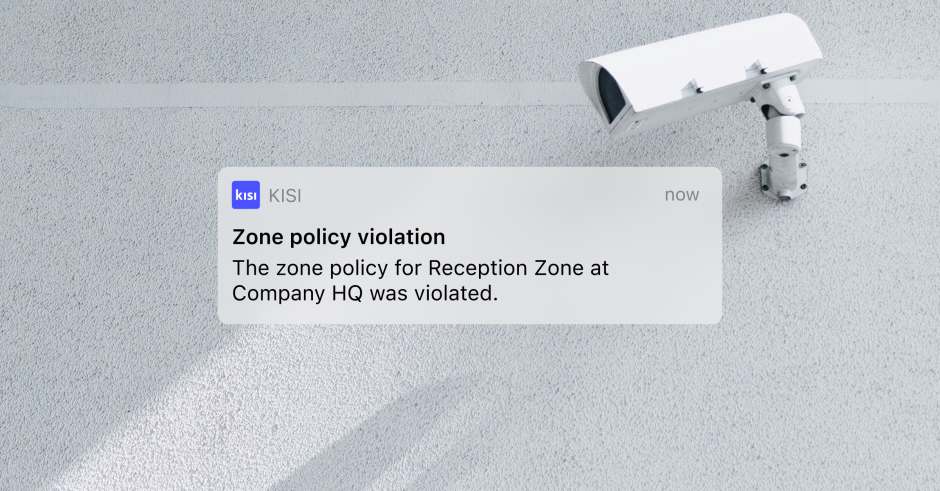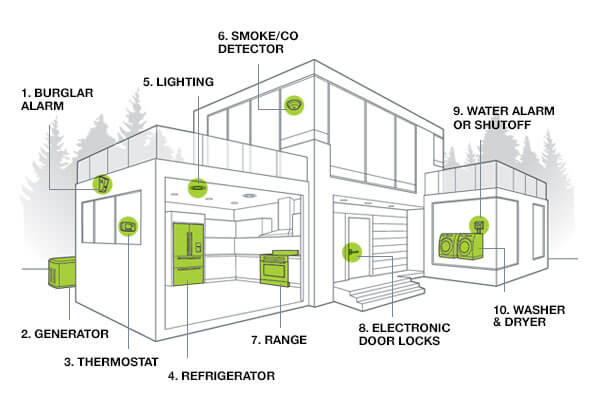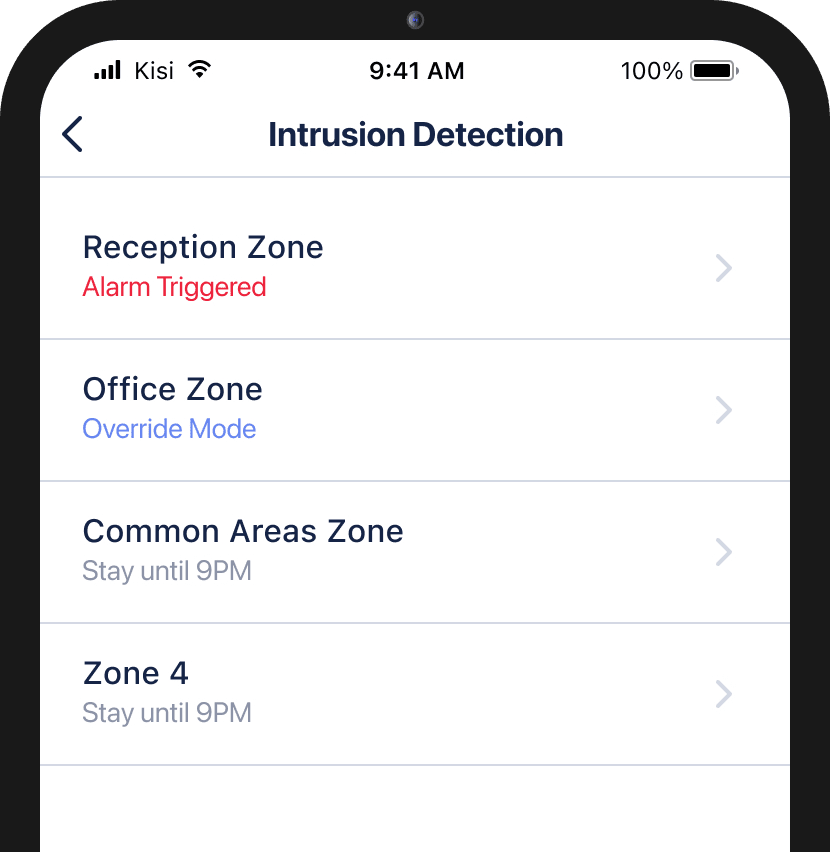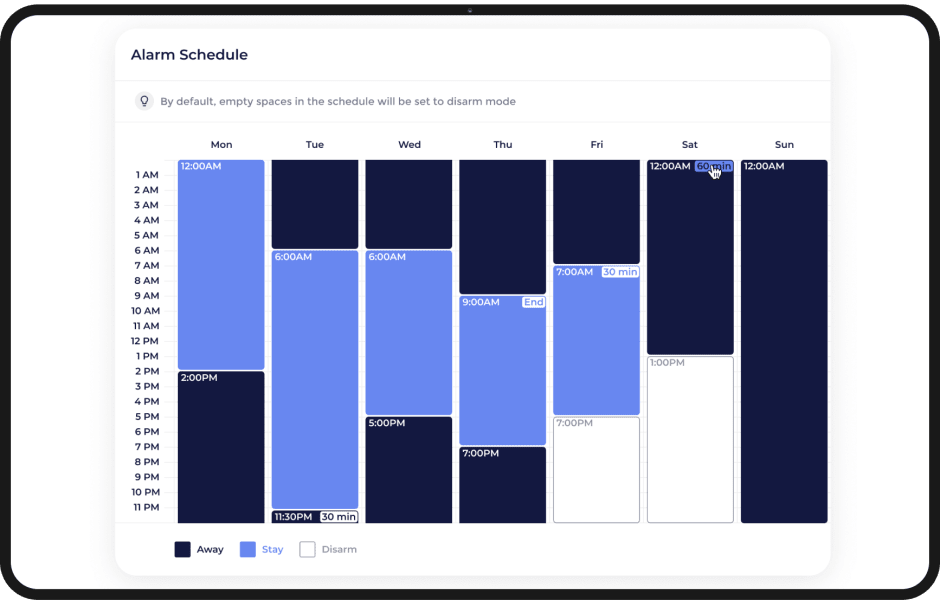Intrusion Alarm Systems Overview
Understanding Intrusion Alarm Systems and how to choose and install the right one.
01
What is an Intrusion Alarm System?
An intrusion alarm system is a system whose aim is to monitor and detect unauthorized access to a building. These systems are used for different purposes and in different contexts both residential or commercial. The main purpose of an intrusion alarm system is to protect from burglary, vandalism, property damage, and, of course, the security of the individuals inside the building.

As we will see later in the article, there are many different types of intrusion alarm systems that can be standalone elements (like a glass-break sensor) or fully incorporated security ecosystems with CCTV cameras and access control. However, for the sake of clarity, we have dedicated separate overviews to access control and video surveillance systems. By doing so we will be able to focus better on the smaller components that help to keep your building safe.
Download our guide to intrusion detection
Discover the best solutions to protect your business.
02
Types of Intrusion Alarm Systems
Basically, we have two types of intrusion alarms available: Do-it-yourself security system and security systems by professional firms. Home security pundits warn that DIY alarms make you responsible for contacting the police or other emergency services in case of an accident, while professional security firms usually bear that responsibility themselves in exchange for a monthly fee.

Nonetheless, manufacturers of DIY security systems offer complete security suites that feature window and door sensors, locks, motion and glass break detectors, sirens, and other vital components of a reliable intrusion prevention system for your home or small office. A limited number of security firms also provide monitoring services that, in contrast to contracts by established companies, have no fixed term and do not bound you with a two- or three-year service contract.
There various types of intrusion detection systems:
Wireless vs. Hardwired Intrusion System
Hardwired home and office alarm systems are considered to provide a higher level of security, as a whole. However, the latest wireless systems are as reliable as their cable-powered counterparts are. Plus, wireless technologies offer a growing number of advantages in the field of home and office security. You cannot tell which of those two alternatives is the best intrusion detection system without taking into account additional factors.
Monitored and Unmonitored Alarms
A monitored or unmonitored burglar alarm can be either hardwired or a wireless system. An unmonitored intrusion alarm usually activates a siren or another noisy device once a sensor within the security system has detected an intrusion. It is not a very suitable solution for remote properties and real estate in rural areas, though.

Monitored home alarms are connected to a third party for monitoring. The sensors both trigger an alarm and send an alert to the monitoring party. Modern-day security systems are also able to connect and alert you to any events on your smartphone or another mobile device. Obviously, this type of home and/or office security solution is more expensive since you usually get a 24/7/365 monitoring service for your property.
Dummy Intrusion Alarms
These are the cheapest intrusion protection tools, but they work only as a sort of decoy. It is quite debatable whether a possible burglar will be stopped by such a visible dummy alarm and if a professional thief would ever be misguided enough to take it for a professional security system, but it sometimes works.
Auto-dialing Security Systems
Security systems that feature an autodialer are able to connect to a preset phone number or numbers in case of emergency. For example, you can have a pre-recorded voice message sent to the police, to a security firm of your choice, or to the local firefighters. You can complement such functionality with in-house motion sensors that detect whether there is someone inside the property, helping the local security authorities assign a proper priority to the accident.
Arm Alarm
Arming your access control system’s alarm is an important and necessary feature that works to protect your space. When a home has a security system, for example, the system is not always on — it’s only armed when the owner is gone. This logic can easily be applied to your own security system. During a normal workday, you might not need to have your alarm armed because you and your team will be present.
At other times, though, it’s necessary to have your system’s alarms ready to go. During the evening or on days with high foot traffic, you should consider arming your alarm, which will immediately alert your entire operations team with a message or email as soon as someone attempts to access one of those spaces without the proper security clearance. You’ll be able to protect your restricted amenities even when you’re not around, which is an incredibly powerful tool for protecting your office’s assets.
03
Intrusion Alarms Systems Components
As mentioned previously, there are various components that can make up an intrusion alarm system. Many of these components work autonomously, while others work in the context of an ecosystem. In general, we recommend working with components that function well together and that integrate easily with your video surveillance or access control systems. For businesses, in general, it’s very helpful to manage your whole security from an individual dashboard, as it makes life easier for the security specialists/office managers and, at the same time, reduces the chances of human error.
Motion Sensors
Motions sensors will detect movement within your facility and trigger the alarm consequently. There are many types of motion sensors. Here we take a look at infrared, microwave, and ultrasonic sensors.
Infrared Sensors (or IR Sensors)
Infrared sensors are components that work with infrared radiation to analyze it in relation to its surroundings. There are two types of infrared sensors: active infrared sensors and passive infrared sensors (PIR). The IR that are normally used within residential and commercial security are the passive ones. Infrared sensors work with temperature, using infrared radiations to measure the temperature of the objects in a room.
On the other hand, active infrared sensors both emit and receive infrared radiation. They are mostly used in proximity-based use cases, as they project infrared radiations that hit an object and bounce back to the receiver. By doing so, the active infrared sensor knows how far an object is. For intrusion-related issues, however, we are only interested in knowing if an intrusion is taking place and not necessarily how far from the sensor the intruder is. That is why PIR sensors are so widespread.
Instead of emitting infrared radiation, passive infrared sensors are only detecting radiations in the surroundings and only trigger the alarm if there are objects that have a much higher temperature than what is around them, like an intruder.
If you want to know more about PIR sensors, we have created a dedicated guide that you can find here.
Microwave and Ultrasonic Sensors
Microwave sensors and ultrasonic sensors work similarly to the infrared ones, meaning that they also use some kind of frequency to detect motion changes in a room. Instead of using infrared radiations, however, the microwave sensors emit and receive microwave radiations and the ultrasonic sensors receive sound waves.
Whereas ultrasonic sensors are comparable in terms of pricing and performance to the PIR sensors, the microwave sensors come with a slightly higher price tag and are mostly used by businesses. Take this into account while looking for the best intrusion system.
Contact Sensors (or Contact Switches)
Another category of sensors is contact sensors. As the name suggests, they do focus on contact rather than motion, making them especially effective as perimetral defense for an office as they detect if something comes in contact with a door or a window.
Door and Window Sensors
Door and window sensors are contact sensors that trigger the alarm when a door or a window is opened. They work with a magnet and a sensor both installed on the door/window but in different parts. The magnet is installed on the door itself, whereas the sensor is placed on the door frame. The alarm is triggered once the magnet moves (so if the door or window is opened) away from the sensor.
There are two types of door sensors, wireless sensors, and hardwired sensors. Each of these is a valid alternative, and they both have their pros and cons. Hardwired sensors require a more laborious and expensive installation and are less esthetically pleasing, as they require cables being installed all over the facility. Their advantage is that they do not require batteries (so no maintenance costs).
Wireless sensors, on the other hand, have an extremely simple installation process as they come ready “out-of-the-box” and are, in general, perceived as more aesthetically pleasing since they do not require cables. Wireless sensors, however, work with batteries. This means that you will need to make sure every sensor is functioning, and you will have higher maintenance costs in the long term compared to the hardwired ones.
We also have a dedicated guide on door alarms, in case you are looking for more information.
Glass-break sensors
The third type of sensor does not belong to any of the aforementioned groups. These are the glass-break sensors. A glass-break sensor makes sure that nobody breaks into your facility by shattering the glass of a window/door. These sensors do not generally work with magnetic fields, but with vibrations.
The sensor is installed on the glass that you want to monitor and triggers the alarm in case the vibrations of the glass that is being monitored change rapidly (for example, if someone hits the glass very hard or if the glass breaks). With this technology, especially if paired with door and window contact sensors, you can efficiently monitor the entry points of your facility.
Click here for the Kisi glass-break-sensors guide.
Move intrusion detection to the cloud
Enhance security and ensure cost-effectiveness with modern cloud-based access control and alarm policies.
04
Intrusion Alarm Manufacturers
Now that we have covered what the main types and components of intrusion alarm systems are, it’s time to go through what different brands offer with regards to these systems. There are several brands across the world that focus on delivering high-quality devices and support services to install and maintain optimal security solutions for businesses.
Kisi
Kisi has released its Intrusion Detection solution in 2021, with the intention of solving the most common customer complaints when it comes to intrusion detection systems. The main complaints were that:
- The majority of the systems work with outdated technology, making it difficult to maintain and scale. This also has a big impact on the price tag, as maintenance is more frequent (and, consequently, more expensive).
- Many companies offer great intrusion hardware but it is not always clear if it is compatible with what the company already has in place.
- Having access policies separated from alarm policies facilitates false alarms, poor user experience, and more complex maintenance processes.
With Kisi, all of this disappears thanks to the native Intrusion Detection feature. You can get your sensors from third-party suppliers or directly order them with Kisi to create an environment in which access control

and intrusion alarm policies are managed from the same platform, working hand in hand.
Having this kind of solution not only helps you with the maintenance and setup (that our customer service guides you through) but also offers you a great chance to save tons of expenses in the future as Kisi grows with your company. Plus, Kisi is an individual platform instead of the two or three you would otherwise have to work with.
If you want to learn more about our feature, you can check out our product page or get in contact with our sales team.
Simplisafe
Simplisafe’s technology has gathered many great reviews in recent years thanks to the perfect match of inexpensive hardware and great performance. You can possibly get a full security system (minus access control) from Simplisafe, and you won’t be disappointed.
Their product offerings range from motion sensors to security cameras, all of which are compatible with each other, allowing you to create a great security ecosystem within your company.
The usual critiques for Simplisafe solutions are the lack of many smart home features (especially bothering private customers) and the need to purchase the hardware upfront. Purchasing the hardware upfront makes you more dependent on their solution from a certain point of view, but it also means that there are no big legal obstacles in case you want to completely move away from Simplisafe in the future.
Lastly, it is important to mention that the Simplisafe hardware is wireless and this makes the maintenance cost a bit higher, as the batteries need to be changed periodically. Overall, Simplisafe is tough to beat if you’re looking for a security system and you are on a budget.
BOSCH
BOSCH is a well-known security solution across the world, providing a wide range of access control and intrusion alarm products. Some of BOSCH’s offerings include security cameras, intrusion sensors, security monitoring software, and access control options.
Overall, BOSCH is a reliable security solution, although some customers do complain that the company is not as technologically advanced as competitors. On the other hand, this can be partially overcome by using BOSCH with 3rd party systems that easily integrate with their cameras and alarms. For example, BOSCH integrates with Kisi’s access control software, allowing users to combine BOSCH products with more innovative security solutions.
Keep in mind BOSCH products can be a bit pricier than some other providers, because they are a German-based company, meaning all their products must be imported to the U.S. But for companies willing to pay the higher price, BOSCH offers highly competitive intrusion alarm systems.
Johnson Controls
Johnson Controls offers a number of products, from HVAC to building automation to security. They offer perimeter protection, alarm systems, surveillance cameras, and panic devices. Each piece of their security offerings can work well together, allowing customers to craft a custom solution for their business. While their line of products may seem impressive, security is just one of the many things the company is focused on, meaning it does not specialize in intrusion solutions like many of its competitors.
Compared to other intrusion alarm manufacturers, Johnson Controls is slightly lesser-known. A number of customers also complain of poor customer service and slow reaction to on-site issues from the company, despite 24/7 customer service.
Honeywell
Honeywell security systems are a reliable form of security for home and business alike. They provide all the usual offerings, like security cameras, alarms, and access control. Unlike Simplisafe, a number of Honeywell’s security products require a professional to come out to your site to price and install, but this is because of advanced features that allow you to build a fairly complex and well-rounded system.
Honeywell is especially appealing to modern businesses because much of their equipment can be monitored and controlled remotely. The systems can also easily be upgraded and scaled as a business grows, and it integrates with a number of other products and services, making it fairly customizable to your needs.
ADT
ADT provides comprehensive commercial security solutions, starting with physical options like cameras and intrusion alarms and extending all the way to monitoring, data collection, and access control.
While ADT is very well known and reliable, it’s also one of the pricer security solutions on the market. From the physical products to installation fees, to monitoring fees, these costs can add up quickly. For the price, though, you’re getting a well-thought-out, thorough intrusion alarms system from a company that has been trusted for over 100 years.
ADT provides a full-service security system, but this comes with some caveats. Unlike some other providers, ADT needs to be installed by a professional, even if you’re only looking for something at the home security level. They also offer very few integration opportunities, which can limit businesses from streamlining business operations.
Linear
Linear focuses on access control as their primary security measure. They offer door readers that simplify access to facilities as well telephone-operated access control. Their offerings extend to physical perimeter control, as well, with gate operators for commercial spaces.
Linear access control products are easily scalable as a business grows, making them an ideal pick for smaller companies looking to expand. Linear also integrates with Kisi, which can help you build a seamless security system for your space.
Assa Abloy
Assa Abloy provides access control and security solutions like sliding doors, automatic locks, and software for property management. These products integrate with Kisi to help you protect your space with premium access control measures.
With Assa Abloy, you can be confident knowing the entrances to your spaces are securely locked when necessary and will only open when access is granted. Products like sliding and revolving doors that are motion activated also help you keep an eye on who enters your business, helping you secure the perimeter of your space. How to choose an intrusion alarm manufacturer.
05
How to Choose an Intrusion Alarm
While there are many different ways to secure your business, it is clear that no matter what kind of business you’re in, how big it is, or where you’re based, there will always be a need for optimal security. There are many different components to a good security system, and intrusion detection is just one of them.
Our two criteria for choosing the best intrusion detection system components are trust and integrability. Obviously, you should trust the company that you choose your security system from. It should be a business that has reliable products and a history of satisfied customers. Kisi, for example, has the highest app ratings within all access control companies, and this is one of the reasons why people trust us with their safety.
With regards to integrability, we love systems that integrate with other components of the security ecosystem. Intrusion alarms are good, but intrusion alarms that seamlessly integrate with your access control and cameras are next level. If you’re interested in knowing more about security brands, we have created an extensive guide about the best commercial security alarms.
Below, we’ve collected some questions you should ask yourself when choosing an alarm system for your company.
Project Management
Before starting the project, ask yourself these questions:
- How much am I willing to spend upfront?
This will help you decide if you want your hardware hardwired or wireless. Hardwired has higher upfront costs for installation but lower maintenance costs (they don’t work with batteries) and wireless hardware has lower upfront costs, with the maintenance cost of the batteries through the years.
- How does my current security hardware integrate with intrusion alarms?
In case you do have security cameras or an access control solution in place, we suggest you look for a solution that can easily integrate with them. Remember: the lower the number of dashboards, the less time spent on maintenance, and the lower the risk of human error from the admins. More about integrating intrusion alarms and access control can be found in the last paragraph.
- What is my timeline?
Some alarms require more time to be installed. If you have no time restrictions, try to focus on a solution that can last for years and that can grow with you.
Product Features
Questions you should consider when looking for a product.
- Is the motion sensor/contact sensor wireless or hardwired?
We’ve covered the differences in the paragraphs above.
- Is the dashboard clear and easy to use?
If your company does not work with a dedicated security team, you want to make sure that working and maintaining the alarm system is something an admin can do securely. This is why compatibility and a clear and easy dashboard are crucial criteria.
06
Kisi’s Intrusion Alarms Offering
Kisi offers a powerful intrusion alarm system that allows you to combine access policies with alarm policies, seamlessly set alarm zones, reduce false alerts, review potential breaches with visual snapshots, and a lot more. With our solution, you will be able to use Kisi as the brain of your security system, with access control and intrusion detection working out-of-the-box and a native security cameras integration. You will be able to control everything from your Kisi dashboard and from every device, whether a laptop, tablet, or even mobile.
The Kisi Advantage
In terms of security, Kisi has the advantage of being extremely scalable. Our solution really is flexible and allows you to scale without worrying about security. Kisi grows with your company and lets you easily incorporate more contact sensors, cameras, and access control hardware without needing to have separate reporting and dashboards.

Moreover, Kisi minimizes false positives alarms by ensuring our intrusion policies take precedence over access policies, just one more advantage of running your intrusion detection and access control on the same platform. Our pricing plan also makes it more convenient for you to scale up as the cost of the software remains the same.
These are some of the features that set Kisi Intrusion Detection apart from any other system:
- Seamless experience: security rules that take precedence over members' access rights, reducing false positives.
- Customization: get notified about security events only when it's relevant.
- Remote management: see and change the arming status from anywhere with the Kisi mobile app.
- Smart automation: set alarm modes automatically based on activity in the building.
- Easy setup: no additional hardware or installation required.
- Simplicity of use: manage physical security all from one dashboard.
For more information about our native solution, you can visit our product page or contact our sales team.
Download our guide to intrusion detection
Discover the best solutions to protect your business.
Enable cookies to help us improve your experience.
We use cookies to enchance your experience and for marketing purposes. By clicking ‘accept’, you agree to this use.